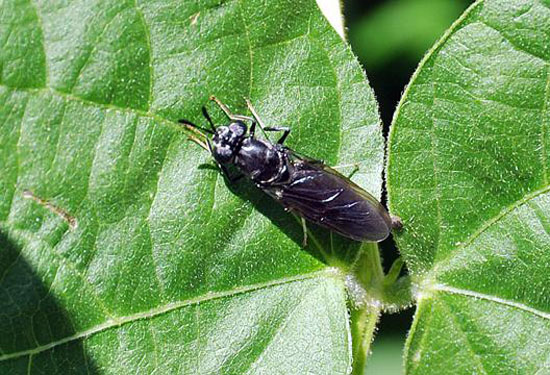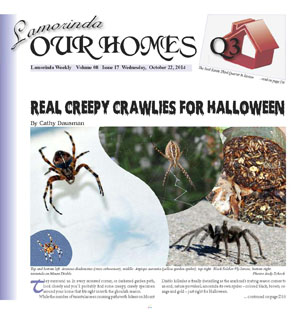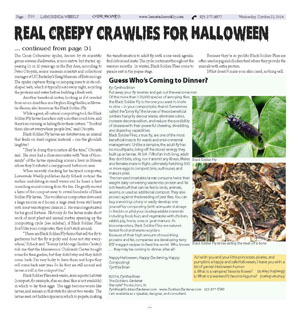|
|
Published October 22nd, 2014
|
Real Creepy Crawlies for Halloween
|
|
| By Cathy Dausman |
 |
| Top and bottom left: Araneus diadematus (cross orbweaver); middle: Argiope aurantia (yellow garden spider); top right: Black Soldier Fly larvae; bottom right: tarantula on Mount Diablo Photos Andy Scheck |
They surround us. In every recessed corner, or darkened garden path, look closely and you'll probably find some creepy, crawly specimen around your home that fits right in with the ghoulish season.
 While the number of tarantulas seen crossing paths with hikers on Mount Diablo hillsides is finally dwindling as the arachnid's mating season comes to an end, nature provides Lamorinda its own spider - colored black, brown, orange and gold - just right for Halloween. The Cross Orbweaver spider, known by its scientific genus araneus diadematus, is non-native but started appearing 15 or 20 years ago in the Bay Area, according to Peter Oboyski, senior museum scientist and collections manager at UC Berkeley's Essig Museum of Entomology. The spider captures flying or jumping insects in its orb-shaped web, which it typically eats every night, recycling the proteins and water before building a fresh web.
While the number of tarantulas seen crossing paths with hikers on Mount Diablo hillsides is finally dwindling as the arachnid's mating season comes to an end, nature provides Lamorinda its own spider - colored black, brown, orange and gold - just right for Halloween. The Cross Orbweaver spider, known by its scientific genus araneus diadematus, is non-native but started appearing 15 or 20 years ago in the Bay Area, according to Peter Oboyski, senior museum scientist and collections manager at UC Berkeley's Essig Museum of Entomology. The spider captures flying or jumping insects in its orb-shaped web, which it typically eats every night, recycling the proteins and water before building a fresh web.
 Another beneficial critter, looking as if it crawled from an un-dead face in a Stephen King thriller, is Hermetia illucens, also known as the Black Soldier Fly.
Another beneficial critter, looking as if it crawled from an un-dead face in a Stephen King thriller, is Hermetia illucens, also known as the Black Soldier Fly.
 While a great, all-natural composting tool, the Black Soldier Fly larvae has a face only a mother could love, and there's no running or hiding from these critters. "You find them almost everywhere people live," said Oboyski.
While a great, all-natural composting tool, the Black Soldier Fly larvae has a face only a mother could love, and there's no running or hiding from these critters. "You find them almost everywhere people live," said Oboyski.
 Black Soldier Fly larvae are detritavores, an animal that feeds on dead organic material - cue the ghoulish laughter!
Black Soldier Fly larvae are detritavores, an animal that feeds on dead organic material - cue the ghoulish laughter!
 "They're doing this in nature all the time," Oboyski said. He once had a close encounter with "tens of thousands" of the larvae spreading across a lawn in Hawaii where they'd infested a campground bathroom area.
"They're doing this in nature all the time," Oboyski said. He once had a close encounter with "tens of thousands" of the larvae spreading across a lawn in Hawaii where they'd infested a campground bathroom area.
 When recently checking his backyard composter, Lamorinda Weekly publisher Andy Scheck noticed the surface undulating in small waves and he heard a faint crunching sound coming from the bin. He gently moved a layer of the compost away to reveal hundreds of Black Soldier Fly larvae. The vociferous composters devoured a large zuccini in 6 hours; a large steak bone still heavy with meat was stripped clean in 2. He was congratulated for his good fortune. Not only do the larvae make short work of most plant and animal matter, speeding up the composting cycle (see sidebar), if Black Soldier Flies don't like your composter, they don't stick around.
When recently checking his backyard composter, Lamorinda Weekly publisher Andy Scheck noticed the surface undulating in small waves and he heard a faint crunching sound coming from the bin. He gently moved a layer of the compost away to reveal hundreds of Black Soldier Fly larvae. The vociferous composters devoured a large zuccini in 6 hours; a large steak bone still heavy with meat was stripped clean in 2. He was congratulated for his good fortune. Not only do the larvae make short work of most plant and animal matter, speeding up the composting cycle (see sidebar), if Black Soldier Flies don't like your composter, they don't stick around.
 "There are Black Soldier Fly farms that sell the fly to gardeners but the fly is picky and does not stay everywhere," Scheck said. "Kenny (at Moraga Garden Center) told me that the Merriewood Children's Center bought some for their garden, but they didn't stay and they didn't come back. I'm very lucky to have them and hope they will come back next year. So far they are still around and larvae is still in the compost bin."
"There are Black Soldier Fly farms that sell the fly to gardeners but the fly is picky and does not stay everywhere," Scheck said. "Kenny (at Moraga Garden Center) told me that the Merriewood Children's Center bought some for their garden, but they didn't stay and they didn't come back. I'm very lucky to have them and hope they will come back next year. So far they are still around and larvae is still in the compost bin."
 Black Soldier Flies seek warm, semi-aquatic habitats (compost, for example, if an un-dead face is not available) in which to lay their eggs. The eggs become worm-like larvae, and remain in that state for about two weeks. The larvae seek out hidden spaces in which to pupate, making the transformation to adult fly, with a one week agenda: find debris and mate. The cycle continues throughout the warmer months. In winter, Black Soldier Flies come to parade rest in the pupae stage.
Black Soldier Flies seek warm, semi-aquatic habitats (compost, for example, if an un-dead face is not available) in which to lay their eggs. The eggs become worm-like larvae, and remain in that state for about two weeks. The larvae seek out hidden spaces in which to pupate, making the transformation to adult fly, with a one week agenda: find debris and mate. The cycle continues throughout the warmer months. In winter, Black Soldier Flies come to parade rest in the pupae stage.
 Because they're so prolific Black Soldier Flies are often used in pig and chicken feed where they provide the animals with extra protein.
Because they're so prolific Black Soldier Flies are often used in pig and chicken feed where they provide the animals with extra protein.
 If that doesn't make your skin crawl, nothing will.
If that doesn't make your skin crawl, nothing will.

|
 Guess Who's Coming to Dinner? Guess Who's Coming to Dinner?
 By Cynthia Brian By Cynthia Brian
 Put away your fly swatter and get out the welcome mat. Put away your fly swatter and get out the welcome mat.
 Of the more than 120,000 species of annoying flies, the Black Soldier Fly is the one you want to invite to dine - in your compost pile, that is! Sometimes called the "privy fly," the larvae of these beneficial soldiers hungrily devour waste, eliminate odors, increase decomposition, and reduce the possibility of disease with their powerful chewing, shredding, and digesting capabilities. Of the more than 120,000 species of annoying flies, the Black Soldier Fly is the one you want to invite to dine - in your compost pile, that is! Sometimes called the "privy fly," the larvae of these beneficial soldiers hungrily devour waste, eliminate odors, increase decomposition, and reduce the possibility of disease with their powerful chewing, shredding, and digesting capabilities.
 Black Soldier Flies, a true fly, are one of the most beneficial insects for waste and environmental management. Unlike a vampire, the adult fly has no mouthparts, living off the stored energy they built up as larvae. At 3/4 -7/8 of an inch long, adult flies don't bite, sting, nor transmit any illness. Males and females mate in flight, ultimately hatching 500 or more eggs in compost bins, outhouses, and manure piles. Black Soldier Flies, a true fly, are one of the most beneficial insects for waste and environmental management. Unlike a vampire, the adult fly has no mouthparts, living off the stored energy they built up as larvae. At 3/4 -7/8 of an inch long, adult flies don't bite, sting, nor transmit any illness. Males and females mate in flight, ultimately hatching 500 or more eggs in compost bins, outhouses, and manure piles.
 The non-pest insatiable larvae consume twice their weight daily converting waste into protein and fat rich feedstuff that can be fed to birds, animals, worms, or used as additional compost. They also protect against the breeding of pest flies. You can buy a working colony or easily develop one yourself by composting (with adequate drainage in the bin or pile) your biodegradable materials including food, fruit, and vegetables with chicken, rabbit, pig, horse, cow, or goat manure. As biocomposters, Black Soldier Flies are nature's fastest food and waste recyclers. The non-pest insatiable larvae consume twice their weight daily converting waste into protein and fat rich feedstuff that can be fed to birds, animals, worms, or used as additional compost. They also protect against the breeding of pest flies. You can buy a working colony or easily develop one yourself by composting (with adequate drainage in the bin or pile) your biodegradable materials including food, fruit, and vegetables with chicken, rabbit, pig, horse, cow, or goat manure. As biocomposters, Black Soldier Flies are nature's fastest food and waste recyclers.
 Because of their high amount of nourishing proteins and fat, companies are developing tasty BSF maggot recipes to feed the world. Who knows ... they may be coming to dinner after all! Because of their high amount of nourishing proteins and fat, companies are developing tasty BSF maggot recipes to feed the world. Who knows ... they may be coming to dinner after all!

 Happy Halloween, Happy Gardening, Happy Composting! Happy Halloween, Happy Gardening, Happy Composting!
 Cynthia Brian Cynthia Brian

 (c)2014, Cynthia Brian (c)2014, Cynthia Brian
 The Goddess Gardener The Goddess Gardener
 Starstyle(r) Productions, llc Starstyle(r) Productions, llc
 Cynthia@GoddessGardener.comwww.GoddessGardener.com 925-377-STAR Cynthia@GoddessGardener.comwww.GoddessGardener.com 925-377-STAR
 I am available as a speaker, designer, and consultant. I am available as a speaker, designer, and consultant.
 |
| Black Soldier Fly |
 |
| Black Soldier Fly larvae eating the meat off a bone |
|
|
|
|
| |
|
|
|
|







